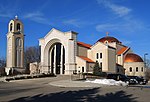Englewood Cliffs, New Jersey

Englewood Cliffs is a borough in Bergen County, New Jersey, United States. As of the 2010 United States Census, the borough's population was 5,281, reflecting a decline of 41 (-0.8%) from the 5,322 counted in the 2000 Census, which had in turn declined by 312 (-5.5%) from the 5,634 counted in the 1990 Census.The borough houses the world headquarters of CNBC (NBCUniversal), the North American headquarters of South Korean conglomerate LG Corp, and the American headquarters of global CPG conglomerate Unilever, and was home to both Ferrari and Maserati North America.The borough's formation dates back to an election for Road Commissioner in Road District 1 between William Outis Allison and Clinton Blake, a future mayor of Englewood. Blake won the vote, but Allison challenged the result, arguing that women had been improperly allowed to vote. The vote was overturned, but Englewood officials would not seat Allison; this ultimately led to his successful efforts in 1895 to have Road District 1 secede to form the Borough of Englewood Cliffs, with Allison serving as the new municipality's first mayor.Englewood Cliffs was formed as a borough on May 10, 1895, from portions of the now defunct townships of Englewood Township and Palisades Township, based on the results of a referendum held the previous day. The borough was formed during the "Boroughitis" phenomenon then sweeping through Bergen County, as of one two boroughs created in 1895 after 26 boroughs had been formed in the county in 1894 alone.
Excerpt from the Wikipedia article Englewood Cliffs, New Jersey (License: CC BY-SA 3.0, Authors, Images).Englewood Cliffs, New Jersey
Long Path,
Geographical coordinates (GPS) Address Nearby Places Show on map
Geographical coordinates (GPS)
| Latitude | Longitude |
|---|---|
| N 40.889721 ° | E -73.941981 ° |
Address
Long Path
Long Path
07632
New Jersey, United States
Open on Google Maps






